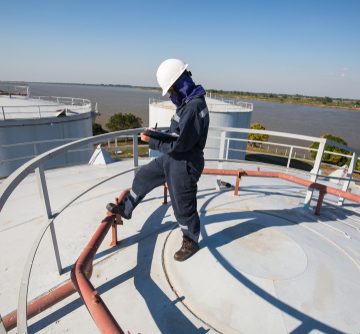Tank inspection usually requires monthly visual inspection and ultrasonic thickness testing. The latter can happen after a few years when the tank was put into service or depending on the application and requirements. This kind of inspection is conducted on both the exterior and interior surfaces of the tank.
What happens during tank inspection
During tank inspection we usually look for corrosion and defects both inside and outside. That’s because tanks are usually made in metal, which can react with oxygen, water and other liquid content. Aside from compromising the integrity of the tank, this also results in the contamination of the valuable contents such as water, fuel and industrial chemicals.
It’s important to promptly spot those defects and signs of corrosion. This way we can prolong the tank’s useful lifetime as well as protect the chemical integrity of the contents. Even with the application of highly resistant coatings (e.g. paint-based, epoxy), corrosion can still happen in microsites and spots that are unprotected or compromised. It’s just a matter of time before signs of damage appear. What we can do then is to prevent damages from getting worse. This way repairs will be done early and prevent costly downtimes.
To prevent things from getting worse, a reliable inspection and testing method should be implemented. As mentioned earlier, visual inspection and ultrasonic thickness testing are commonly employed. Visual inspection is straightforward and it’s still effective especially if there’s a detailed checklist on how to look for defects and signs of corrosion. When it comes to ultrasonic thickness testing, it works by allowing ultrasound waves to travel through the material and then record the time taken by the ultrasound wave to return to the surface. The time taken varies depending on the material being inspected and the presence of defects. From there we can locate defects and then initiate the required repairs.
In tank inspection, ultrasonic thickness testing is highly useful because it’s a non-destructive testing technique and can be engineered to cope with coatings (even with the coating we can still get reliable results and no need to remove the coating). The needed equipment is relatively cheap and the procedure can be easily performed on site. For example, there are handheld scanners that allow relatively easy, close and complete inspection of the tank floors.
If you require modern and cost-effective non-destructive testing equipment for your tank inspections, you can contact us here at NDT Equipment Sales. We’ll give you competent technical advice on which equipment to choose and use for your application.


